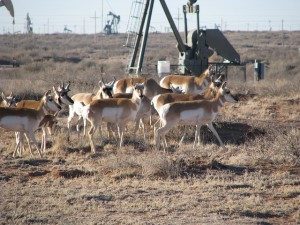We have much more to do and your continued support is needed now more than ever.
Five Species Feeling the Heat from Methane


Methane is the second most prevalent gas in the U.S., after carbon dioxide, and is an extremely potent greenhouse gas, with 80 times the warming impacts of carbon dioxide over a 20 year period.
Reducing methane emissions is of the utmost importance for wildlife like the five species listed below, who continue to be negatively impacted by oil and gas development:
Mule deer
Mule deer are a popular game species throughout the Western United States. However, oil and gas exploration and development have contributed to the decline of mule deer populations in recent years. Since the 1970s, biologists in Colorado, Wyoming and Utah have seen deer populations drop by 50 percent.
According to a recent report, energy development contributes to habitat loss, migration barriers, and toxin ingestion, all of which have the potential to exacerbate mule deer population decline. In addition to the challenge of energy infrastructure, the effects from climate change are also negatively impacting this once common species.
San Joaquin kit fox
This tiny fox with big ears is found only in the San Joaquin Valley in California and is listed under the Endangered Species Act (ESA). The small fox’s range used to cover most of the valley, but development, including oil and gas projects, has degraded and fragmented its habitat. What remains of the fox’s habitat is isolated, with little left of the habitat corridors it needs to travel between open spaces.

Other desert species that share the kit fox’s habitat are the blunt-nosed leopard lizard and the giant kangaroo rat. The giant kangaroo rat is a food source for the fox, and the blunt-nosed leopard lizard lives in the abandoned fox and rat burrows.
This delicate dryland ecosystem has the potential to be harmed by climate change as well as by further oil and gas development. These arid ecosystems already have little in the way of water resources, so more extreme weather and drought has the potential to add pressure to this already vulnerable landscape.
Desert tortoise
This slow moving reptile is a very specialized species which has adapted to extreme environments in the southwest desert ecosystems of the US. Like the San Joaquin kit fox, the desert tortoise is also listed under the ESA. Because it is so carefully adjusted to its environment, any changes that occur have the potential to harm its survival. Some desert tortoise populations in the Western Mojave Desert region of California have declined by almost 90 percent in the past 40 years.
Climate change projections show that the desert tortoise will face even more obstacles in the future. As a reptile, these tortoise have a very limited ability to regulate their body temperature, so they must retreat underground when temperatures climb too high. As the climate warms this will limit the amount of time they have to forage. Drought will also limit their food supply of grasses and wildflowers, which they also depend on for water. In addition to these severe threats, oil and gas development and the resulting roads, pipelines, and other infrastructure will lead to even more habitat loss and fragmentation.

Burrowing owls
This small ground dwelling bird is found throughout much of the Western United States and prefers open grassland and prairie habitat. Oil and gas development has resulted in fragmented habitat, new potential perches for predators, an increase in disruptive noise (which makes it hard for the owl to hear prey), and an increase in nest abandonment. These challenges have had an impact on the tiny owls, and the threat posed by climate change also has the potential to impact the owl’s arid habitats. Drought caused by climate change can reduce the owl’s food sources, increase the risk of fire, and reduce nest success.
Pronghorn

This unique species is the fastest land animal in North America with herds that roam the western grasslands in states like Wyoming, Montana, and Colorado. Unfortunately, pronghorn populations have declined by 40 percent since 1984, partly as a result of oil and gas development blocking their migration routes. The shifts in temperature and precipitation that would result from climate change will also have a significant impact on the grassland and sagebrush habitats on which these already declining pronghorn populations rely.
Take Action
The federal regulations proposed by the EPA and BLM are needed to protect our wildlife and wild places, and the EPA should issue additional rules to limit methane emissions from existing oil and gas sources as soon as possible. With the recent stay issued by the Supreme Court, the need for our government to find every possible avenue to act on climate change is of the utmost importance. Reducing methane waste is straightforward and long overdue.
Encourage the EPA and BLM to take steps to ensure a stable climate.
Take Action




















